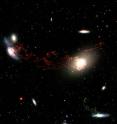Stars stop forming when big galaxies collide
Astronomers studying new images of a nearby galaxy cluster have found evidence that high-speed collisions between large elliptical galaxies may prevent new stars from forming, according to a paper to be published in a November 2008 issue of The Astrophysical Journal Letters. Led by Jeffrey Kenney, professor and chair of astronomy at Yale, the team saw a spectacular complex of warm gas filaments 400,000 light-years-long connecting the elliptical galaxy M86 and the spiral galaxy NGC 4438 in the Virgo galaxy cluster, providing striking evidence for a previously unsuspected high-speed collision between the galaxies. The view was constructed using the wide-field Mosaic imager on the National Science Foundation telescope at Kitt Peak National Observatory near Tucson, Arizona.
"Our data show that this system represents the nearest recent collision between a large elliptical galaxy and a large spiral galaxy," said Kenney, who is lead author of the paper. "This discovery provides some of the clearest evidence yet for high-speed collisions between large galaxies, and it suggests a plausible alternative to black holes as an explanation of what turns off star formation in the biggest galaxies."
Previously, scientists had seen the filaments of gas around both galaxies, but had not seen or inferred any connection between the two galaxies located approximately 50 million light-years from Earth. The new image shows extended and faint emissions that directly connect the two galaxies — and there are no obvious stars in the filaments.
As in most elliptical galaxies, gas within M86 is extremely hot, and radiates X-rays in a long plume, which had previously been interpreted as a tail of gas being stripped as M86 falls into the Virgo cluster. The new image suggests that most of the disturbances in M86 are instead due to the collision with NGC 4438.
"Like with a panoramic camera, the view from the telescope using the wide-field imager at Kitt Peak let us see the bigger picture," said Kenney. "We needed to look deep and wide to see the M86 complex."
A current mystery in astronomy is what causes the biggest galaxies in the universe —primarily elliptical galaxies like M86 — to stop forming stars. "Something needs to heat up the gas so it doesn't cool and form stars," Kenney says. "Our new study shows that gravitational interactions may do the trick."
According to the authors, low-velocity collisions between small- or medium-sized galaxies often produce an increase in the local star formation rate, but in high-velocity collisions that happen naturally between large galaxies, the energy of the collision can cause the gas to heat up so much that it cannot easily cool and form stars.
"The same physical processes occur in both strong and weak encounters, and by studying the observable effects in extreme cases like M86 we can learn about the role of gravity in the heating of galaxy gas, which appears to be quite significant," Kenney adds.
Source: Yale University
Articles on the same topic
- Keck Telescope and 'cosmic lens' resolve nature and fate of early star-forming galaxyWed, 8 Oct 2008, 17:36:25 UTC
- Cosmic eye sheds light on early galaxy formationWed, 8 Oct 2008, 17:36:18 UTC
Other sources
- Stars stop forming when big galaxies collidefrom Science BlogFri, 10 Oct 2008, 10:49:35 UTC
- When It Comes To Galaxies, Diversity Is Everywherefrom Science DailyThu, 9 Oct 2008, 14:35:53 UTC
- Cosmic Eye Sheds Light On Early Galaxy Formation, Just Two Billion Years After Big Bangfrom Science DailyThu, 9 Oct 2008, 2:28:16 UTC
- Keck Telescope and "Cosmic Lens" Team-up to Demonstrate Eventual Power of Thirty Meter Telescopefrom Newswise - ScinewsWed, 8 Oct 2008, 17:42:20 UTC
- Cosmic eye sheds light on early galaxy formationfrom PhysorgWed, 8 Oct 2008, 17:42:17 UTC
- Stars Stop Forming When Big Galaxies Collidefrom Science DailyWed, 8 Oct 2008, 0:14:20 UTC
- Stars stop forming when big galaxies collidefrom Science BlogTue, 7 Oct 2008, 18:49:05 UTC
- Stars stop forming when big galaxies collidefrom PhysorgTue, 7 Oct 2008, 16:07:26 UTC
- Galaxy Diversity Reveals Clues to Cosmic Evolutionfrom Space.comMon, 6 Oct 2008, 11:21:09 UTC
- Galaxy Diversity Reveals Clues to Cosmic Evolutionfrom Live ScienceMon, 6 Oct 2008, 11:21:06 UTC
